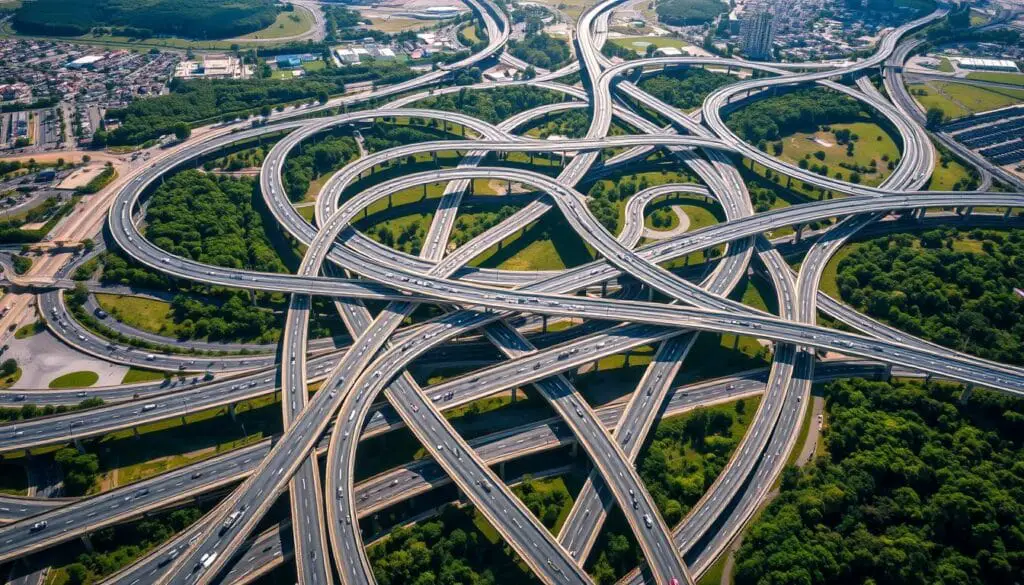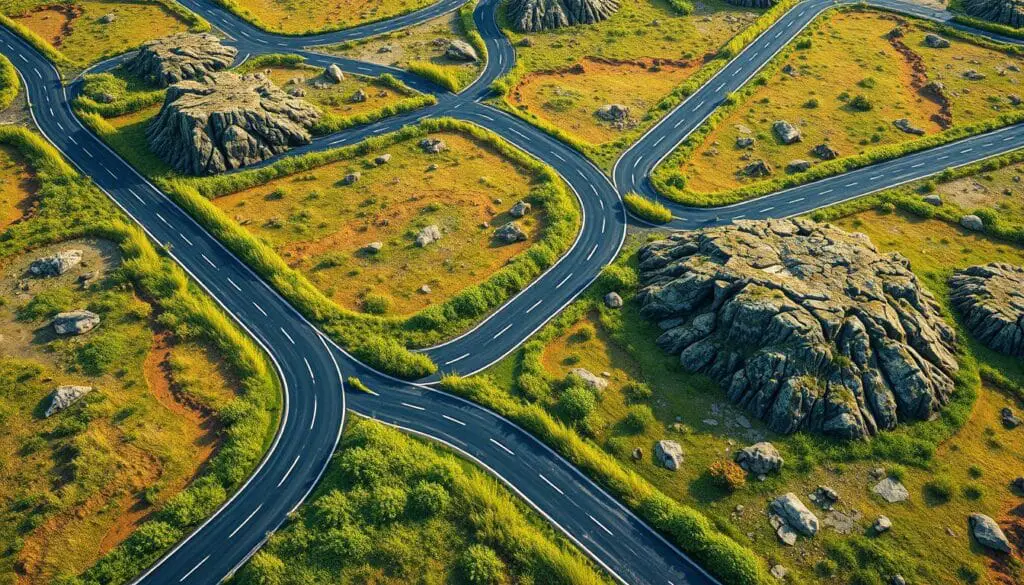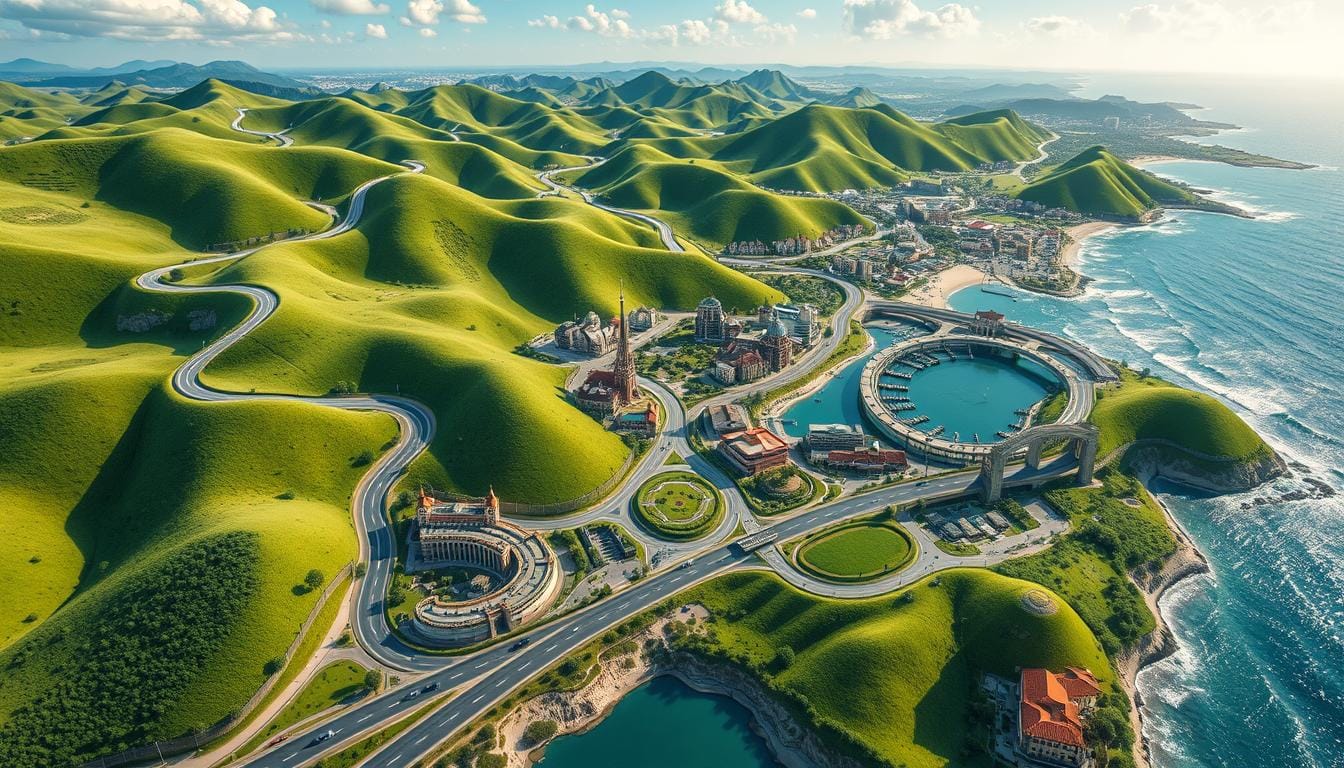Designing Custom BUSSID Maps: A Step-by-Step Guide
I love playing Bus Simulator Indonesia (BUSSID) and creating my own maps. It lets me design bus routes, shape the terrain, and make a virtual world come alive. This guide will show you how to make your own BUSSID maps, giving you the tools to bring your ideas to life.
Table of Contents
Understanding BUSSID Map Creation Fundamentals
Creating custom maps for Bus Simulator Indonesia (BUSSID) requires a deep understanding. You need to know about 3D modeling, level design, and how to integrate gameplay mechanics. As a modder, you’ll learn about the game’s file structure and how to use mod tools to make your ideas come to life.
Basic Map Structure and Components
At the heart of making BUSSID maps is 3D modeling. You’ll learn to create and change 3D assets like terrain, buildings, roads, and objects. This skill makes your maps look great and work well with the game’s mechanics.
Essential Design Principles for Bus Routes
Creating realistic bus routes is key in BUSSID map design. You must think about road layouts, traffic, and how passengers move. Paying attention to bus stops, intersections, and signs makes your map feel real and authentic.
Understanding Scale and Proportions
Keeping the right scale and proportions is vital for your map. It keeps the game’s look and feel consistent. Balancing the size and placement of everything ensures your map feels natural and true to the BUSSID world.
By learning these basics of 3D modeling, level design, and integrating gameplay, you’re on your way. You’ll make custom BUSSID maps that draw players in and show off your modding skills.
Required Tools and Software for Map Design
To make custom BUSSID maps, you need special tools and software. Blender is key for creating detailed landscapes and roads. Programs like GIMP or Adobe Photoshop help make your 3D models look great.
Tools like WinZip or 7-Zip are important for organizing your files. Sites like Nexus Mods, Steam Workshop, and the BUSSID Modding Forums offer lots of help and tutorials.
Creating custom terrain, modeling 3D objects, or finding inspiration in the BUSSID community is easier with the right tools. They help you bring your map ideas to life.
“The right tools can transform your map design from a dream to a reality.”
- 3D modeling software: Blender
- Texture editing tools: GIMP, Adobe Photoshop
- File management utilities: WinZip, 7-Zip
- Modding platforms: Nexus Mods, Steam Workshop, BUSSID Modding Forums
Getting Started with BUSSID Map Editor
The BUSSID Map Editor lets you make your own routes and places for the Bus Simulator Indonesia (BUSSID) game. It has many tools to help you shape the land, add objects, build roads, and customize your map. Learning how to use it well is the first step to making exciting games.
Interface Navigation
The editor’s interface is easy to use, making it simple to find and use its tools. It has different panels for tasks like changing the terrain, adding objects, and making roads. Knowing what each panel does helps you work more efficiently.
Basic Controls and Functions
The editor has many controls and functions to help you work on your map. You can change the terrain height and place objects easily. Learning the basics, like moving the camera and using shortcuts, makes creating your map smoother.
Setting Up Your Workspace
Having a tidy workspace is important for a smooth map-making process. Use the editor’s options to arrange your panels and settings how you like. This helps you stay focused on the important parts of your project.
Knowing how to use the BUSSID Map Editor is the first step to making great maps. With these skills, you can explore more advanced topics like terrain, roads, and environments. These are key to making your BUSSID games stand out.
Terrain Modeling and Landscape Creation
In the world of BUSSID map design, terrain modeling is key. It helps create immersive and realistic environments. You can shape the landscape, making hills and valleys, and diverse terrains that make driving more fun.
Imagine an urban area with skyscrapers or a rural area with rolling hills. The custom terrain creation in BUSSID lets you do it all. With 3D modeling for maps, you can make your vision real. This ensures the environment detailing is stunning and true to life.
Adding natural elements like trees and water is important. So is sculpting the land itself. This makes the driving experience in BUSSID truly captivating.
Spending time on environment detailing makes your BUSSID map come alive. It pulls the player into the game, making it more enjoyable.
Designing Custom BUSSID Maps
Making your own BUSSID maps is a detailed process. It involves planning, creating roads, and adding details to the environment. As a modder, you must think about the map’s structure and layout. This ensures players have a fun and challenging drive.
Planning Your Map Layout
Start by thinking about the main spots, routes, and attractions in your map. Arrange these elements to make a design that looks good and is fun to explore. Make sure the map’s size and scale feel real, making the drive feel immersive.
Creating Realistic Road Networks
Building complex road systems is key in making a custom BUSSID map. Create roads that offer different driving experiences, like mountain paths, city streets, and off-road trails. Your roads should look real and connect well, making the map feel more real.
Adding Environmental Details
Make your map stand out by adding detailed environmental elements. Include realistic buildings, traffic lights, plants, and weather effects. These details can turn your map into a vibrant world that players will love. Focus on the scale and placement of these details to keep the map looking good.
By learning to design custom BUSSID maps, you can offer unique driving experiences. With careful planning, realistic roads, and detailed environments, you can make the BUSSID world more engaging and immersive.
Advanced Road Network Development
Making great BUSSID maps is more than just laying down roads. It’s about creating advanced road networks that excite players. As a level designer, focus on blending gameplay mechanics and custom terrain creation for a deep driving experience.
Designing dynamic city streets is key. These streets should have varied intersections, traffic lights, and lane setups. This makes the driving feel real and fun.
Highway systems are also vital. Building multi-lane freeways, overpasses, and interchanges needs a grasp of traffic and driver behavior. With smart custom terrain creation and gameplay mechanics integration, you can make high-speed driving sequences that thrill players.
Rural roads add variety to your map. Think of winding mountain passes, narrow lanes, and off-road tracks. Your level design skills can craft a network of routes for all player tastes.
Advanced road network development in BUSSID is about finding the right mix of realism and fun. By carefully designing your custom terrain creation and gameplay mechanics integration, you can make the driving experience unforgettable for your players.

| Key Considerations | Desired Outcomes |
|---|---|
| Intersections and Traffic Management | Realistic and challenging traffic flow |
| Highway System Design | Thrilling high-speed driving experiences |
| Rural Road Integration | Diverse range of driving challenges |
| Gameplay Mechanics and Level Design | Seamless integration of realism and enjoyment |
“The true essence of a BUSSID map lies in its ability to captivate players through intricate road networks and immersive driving experiences.”
Implementing Traffic Systems and AI Paths
To make a great BUSSID map, you need to mix realistic traffic and AI paths well. These parts are key to making a fun and tough level for players.
Traffic Flow Configuration
Setting up traffic on your BUSSID map is vital for a real driving feel. By planning how vehicles move, you get a smooth traffic flow. Use map tools to adjust signals, lanes, and speeds for a perfect traffic flow.
AI Waypoint Placement
Putting AI waypoints right is important for guiding AI vehicles. These paths help AI buses and cars move naturally. Good placement makes the game more real and fun for players.
Vehicle Spawn Points
Where you put vehicle spawn points affects the map’s traffic. These spots decide where AI and player vehicles start. Strategic placement can lead to more fun challenges for players.
Getting good at traffic and AI paths is key to a great BUSSID map. With the right tools, you can make a lively and fun world for players.
| Key Features | Benefits |
|---|---|
| Realistic traffic flow configuration | Enhances the immersive driving experience for players |
| Strategically placed AI waypoints | Ensures coherent and natural navigation of AI-controlled vehicles |
| Carefully positioned vehicle spawn points | Maintains a balanced and diverse traffic landscape on the map |
Environment and Scenery Enhancement
Making great BUSSID maps needs careful attention to detail. You must place buildings, trees, and other objects well. This makes your virtual bus routes feel real. Use custom models or existing ones, but make sure they fit the area’s look and feel.
Custom terrain creation is key. It means shaping the land to look real and interesting. With the right tools, you can make different areas blend smoothly, like hills and mountains.
Building placement is also vital. Choose the right styles and sizes to make your map feel real. Think about how buildings face roads and fit with the area around them. This makes your map look natural and connected.
Greenery is also important. Trees, bushes, and more can make your map feel alive. Try different types and amounts to make your map look natural and varied.
Using 3D modeling for maps opens up new possibilities. With the BUSSID map editor, you can make any environment you want. Whether it’s a busy city or a quiet countryside, focus on the details to make your map stand out.
Texture Mapping and Material Design
Making BUSSID maps look amazing means you need to get good at texture mapping and material design. These skills help you make your own textures and put them on 3D models. This makes your game assets look even better.
Creating Custom Textures
Creating unique textures for your BUSSID maps is key to making them stand out. Use image editing software to make your own surface patterns, colors, and details. Try out different styles to match the look you want.
UV Mapping Basics
Putting your textures on 3D models right needs you to know UV mapping. This is about unwrapping the 3D mesh and making a 2D version. Then, you align the texture with the model’s surface. Learning UV mapping helps your textures fit perfectly, without any problems.
Material Optimization
When you make your BUSSID maps look better, think about material optimization too. It’s important to keep the game running well, even with great visuals. Manage your textures well, tweak material settings, and use tricks like texture atlasing. This way, your maps will work well on different computers.
| Feature | Description | Benefits |
|---|---|---|
| Texture Mapping | Applying custom textures to 3D models | Enhances visual realism and creates a distinctive style |
| UV Mapping | Aligning textures to 3D mesh surfaces | Ensures seamless texture integration and prevents distortion |
| Material Optimization | Balancing visual quality and performance | Maintains high-quality visuals while supporting a wide range of hardware |
Learning texture mapping, UV mapping, and material optimization is crucial. It helps you make BUSSID maps that grab players’ attention. These skills are vital for creating custom terrain, designing game assets, and giving players a deep, immersive experience.

“Texture mapping is the secret sauce that turns a good game environment into a great one.” – Game Artist, Jane Doe
Performance Optimization Techniques
Creating custom maps for Bus Simulator Indonesia (BUSSID) is exciting. But, making sure they run smoothly is key. As a modder, you need to balance looks and performance for all players.
Managing texture sizes is a big part of performance. Big textures can slow down games. By making textures smaller, you keep the game looking good without slowing it down.
- Use texture atlasing to fit many small textures into one big one. This cuts down on texture count.
- Texture compression can make your textures smaller without losing quality.
- Have a level of detail (LOD) system. It changes textures based on how far away they are from the player.
Reducing polygon count in 3D models is also important. Too many polygons can overwhelm the GPU. Use mesh simplification and polygon reduction to find a good balance.
Lighting and particle effects also need careful handling. Too much can slow down the game. Baking lighting into textures can help the GPU.
| Optimization Technique | Description | Benefits |
|---|---|---|
| Texture Optimization | Manage texture sizes, utilize texture atlasing, and employ compression algorithms | Reduced texture memory usage, improved performance |
| Polygon Reduction | Utilize mesh simplification and polygon reduction techniques | Decreased GPU load, enhanced performance |
| Lighting and Particle Optimization | Efficiently manage lighting and particle effects, bake lighting information | Lower system resource usage, smoother gameplay |
By using these techniques, your BUSSID maps will run well on many devices. It’s all about finding the right balance. This way, players will enjoy your game on any device.
Testing and Debugging Your Custom Map
Making a top-notch custom BUSSID map needs careful testing and fixing. It’s key to make sure your map is fun and works well for players. Testing helps find and fix many problems.
Quality Assurance Methods
Good quality assurance for your BUSSID map uses different testing methods:
- Playtesting: Get friends who love BUSSID to play your map and share their thoughts on the game, design, and how it feels to play.
- Scenario testing: Make special test cases to find issues like map problems, AI movement issues, or texture bugs.
- Stress testing: See how your map handles a lot of players or complex features to find any weak spots.
Common Issues and Solutions
While testing, you might find common problems to solve:
- Texture glitches: Make sure textures are set up right and materials are optimized to avoid visual problems.
- AI pathing errors: Check your way points and traffic flow to make sure cars move smoothly.
- Performance bottlenecks: Find and make less demanding parts of the map, like complex shapes or high-res textures, to boost speed.
Performance Testing
Checking how well your custom BUSSID map runs is key for a smooth game. Performance testing means:
- Testing frame rates on various devices and setups
- Watching how long it takes to load and how stable it is in different game situations
- Improving the map’s design and assets to keep performance steady
With a detailed testing and fixing plan, you can make your custom BUSSID map better. This way, you can give your players a great experience.
Conclusion
Creating custom maps for BUSSID is a fun and rewarding task. It requires skills in 3D modeling and texture design.
With the right tools and techniques, you can make bus routes that are both realistic and engaging. These routes add to the BUSSID community.
The BUSSID map editor and modding tools are key to creating custom terrains and road networks. By always learning and trying new things, you can make maps that players love.
Designing custom maps for BUSSID is a great way to grow and connect with others. You can make a big impact on the game and help it grow.

